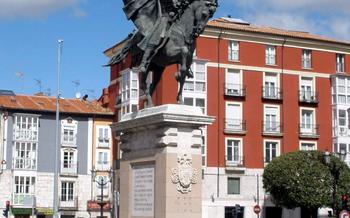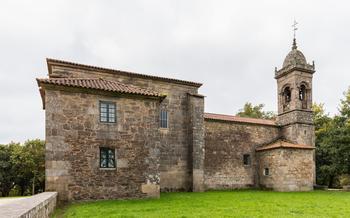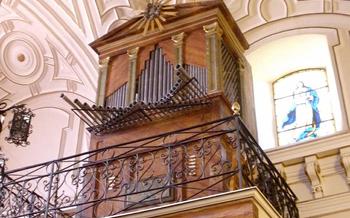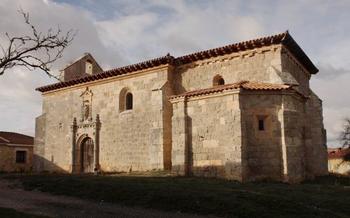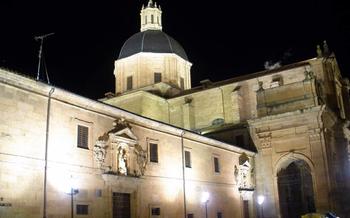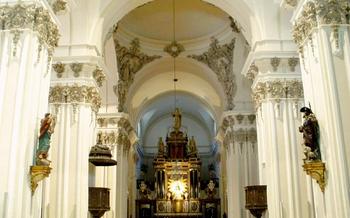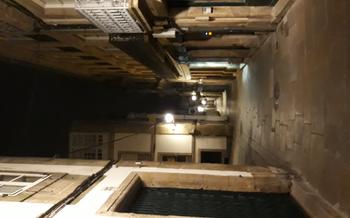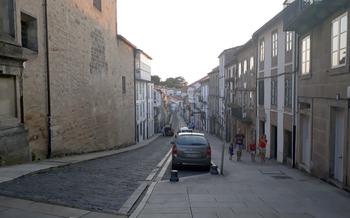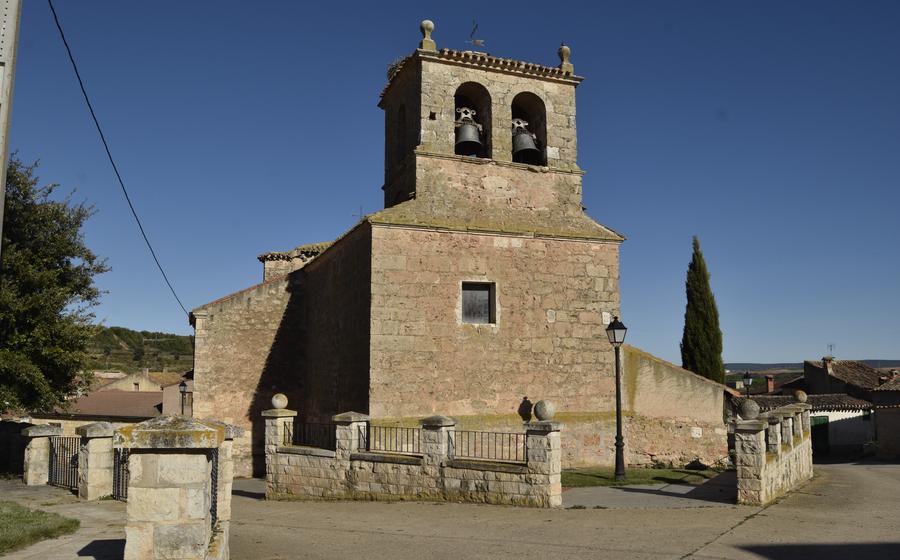
Iglesia de Santa Cecilia
- A Journey Through Time: Exploring the Church's History
- Unveiling the Architectural Masterpiece
- A Realm of Art and Devotion: The Interior of the Church
- The Chapel of the Condestable: A Hidden Gem
- Walking in the Footsteps of Pilgrims: The Camino de Santiago
- A City Steeped in History: Exploring Burgos Beyond the Church
- Recommended Tours and Itineraries
- Capturing the Essence: Photography Tips
- Accessibility and Facilities for Visitors
- Respecting Local Customs and Traditions
- Safety and Security Measures
- Planning Your Visit: Tips for a Seamless Experience
- Insider Tip: Hidden Details to Discover
A Journey Through Time: Exploring the Church's History
The Iglesia de Santa Cecilia stands as a testament to the rich history of Burgos, its foundation dating back to the 11th century. Initially conceived as a humble Romanesque chapel, the church underwent several transformations over the centuries, reflecting the evolving architectural styles and the city's growing significance.
During the 13th century, the church was significantly expanded in the Gothic style, incorporating elements such as pointed arches, ribbed vaults, and intricate stained-glass windows. This period marked the rise of Burgos as a prominent stop on the Camino de Santiago pilgrimage route, attracting countless pilgrims who sought solace and guidance within the church's sacred walls.
In the 16th century, the church underwent further renovations and embellishments, embracing the Renaissance style. The addition of the Chapel of the Condestable, a masterpiece of Renaissance architecture, is a testament to the church's enduring significance and the patronage of wealthy benefactors.
Throughout its history, the Iglesia de Santa Cecilia has witnessed notable events and been associated with influential personalities. It served as the resting place for several members of the powerful Condestable family, whose contributions to Burgos's development were immense. The church's strategic location along the Camino de Santiago also meant that it played a vital role in the cultural and spiritual exchange between pilgrims from across Europe.
Today, the Iglesia de Santa Cecilia stands as a symbol of Burgos's rich heritage, embodying the city's architectural evolution and its enduring spiritual significance. Preservation and restoration efforts have ensured that this historic treasure continues to captivate visitors with its beauty and historical charm.
Unveiling the Architectural Masterpiece
The Unique Design and Structure of the Church Iglesia de Santa Cecilia stands as a testament to the architectural prowess of its creators. Its unique design blends elements from different eras, showcasing the evolution of architectural styles in Burgos. The church's structure features a basilica plan, with three naves separated by elegant columns. The nave is covered by a barrel vault, adding to the sense of grandeur within the sacred space.
Identifying Romanesque, Gothic, and Renaissance Influences The church is a harmonious blend of architectural styles, with Romanesque, Gothic, and Renaissance influences seamlessly intertwined. The Romanesque style is evident in the church's sturdy construction, rounded arches, and intricate carvings. The Gothic elements, such as the pointed arches and ribbed vaults, lend a sense of height and lightness to the interior. The Renaissance influence is manifested in the ornate decoration and elaborate carvings, particularly in the Chapel of the Condestable.
The Construction Materials and Techniques Used The construction of Iglesia de Santa Cecilia involved a combination of materials and techniques that have withstood the test of time. The church's walls are made of locally sourced limestone, quarried from the surrounding hills. The use of buttresses, flying buttresses, and ribbed vaults demonstrates the builders' understanding of structural engineering, ensuring the church's stability and longevity.
Admire the Church's Striking Facade and Bell Tower The church's facade is a feast for the eyes, showcasing a blend of architectural styles. The Romanesque doorway, with its intricate carvings and sculptures, contrasts beautifully with the Gothic elements above. The bell tower, with its octagonal shape and elaborate ornamentation, is a prominent landmark that dominates the city skyline. Its bells have been ringing for centuries, calling the faithful to prayer and marking important events in the life of Burgos.
A Realm of Art and Devotion: The Interior of the Church
Venturing inside the Iglesia de Santa Cecilia is like stepping into a realm of sacred art and devotion. The church's interior is a testament to the skill and artistry of its creators, showcasing a harmonious blend of architectural elements and religious iconography.
The centerpiece of the church's interior is its captivating altarpiece, a masterpiece of intricate carvings and gilded ornamentation. The altarpiece depicts scenes from the life of Christ and the Virgin Mary, inviting visitors to contemplate the sacred narratives.
The stained glass windows, with their vibrant colors and intricate designs, cast a warm glow onto the church's interior. Each window tells a story, depicting biblical scenes, saints, and symbols, inviting visitors to engage with the church's rich iconography.
The walls and pillars of the church are adorned with intricate carvings and sculptures, each one a testament to the skill and artistry of the medieval craftsmen. These carvings depict a variety of subjects, from biblical figures to mythical creatures, adding depth and visual interest to the church's interior.
Finally, the church houses a collection of sacred relics and religious artifacts, each holding a special significance for the faithful. These relics, which include fragments of saints' bones, pieces of the True Cross, and other holy objects, have been venerated by pilgrims and visitors for centuries, adding to the church's spiritual aura.
The Chapel of the Condestable: A Hidden Gem
Within the Iglesia de Santa Cecilia lies a hidden treasure - the Chapel of the Condestable. Built in the 15th century by Pedro Fernández de Velasco, the Constable of Castile, this chapel is a masterpiece of Renaissance architecture. Its exquisite design and intricate details set it apart from the rest of the church, creating an intimate and serene space for contemplation and devotion.
Adorned with an impressive alabaster altarpiece, the chapel showcases the exceptional craftsmanship of the Renaissance period. The altarpiece depicts scenes from the life of Christ and the Virgin Mary, with intricate carvings that bring the stories to life. The tombs of the Condestable and his wife, Mencía de Mendoza, are also located within the chapel, adding to its historical significance.
The Chapel of the Condestable offers a unique and immersive experience for visitors. Its serene atmosphere and beautiful artwork create a sense of tranquility and awe. Visitors can take their time to admire the intricate details of the altarpiece, explore the symbolism behind the stained glass windows, and pay homage to the Condestable and his wife.
Walking in the Footsteps of Pilgrims: The Camino de Santiago
The Iglesia de Santa Cecilia holds a special significance for those embarking on the iconic Camino de Santiago pilgrimage route. Located along the French Way, one of the most popular paths, the church serves as a welcome respite for weary pilgrims. Throughout the centuries, countless pilgrims have sought solace and spiritual renewal within its sacred walls, seeking guidance and protection on their arduous journey.
The Camino de Santiago, also known as the Way of Saint James, is a network of ancient pilgrimage routes that converge in the city of Santiago de Compostela in northwestern Spain. Traditionally, pilgrims from all corners of Europe would set out on foot, following various routes that eventually led them to the shrine of Saint James the Great, one of Jesus's apostles.
The French Way, which begins in the French town of Saint-Jean-Pied-de-Port, is the most widely recognized and traveled route. Passing through some of Spain's most scenic landscapes, the French Way takes pilgrims through historic cities, picturesque villages, and breathtaking natural wonders.
For pilgrims traversing the French Way, the Iglesia de Santa Cecilia marks an important milestone. Situated in the heart of Burgos, the church provides a place for pilgrims to rest, pray, and gather strength before continuing their journey. Many pilgrims choose to attend mass or light a candle in the church, seeking divine guidance and protection for the remainder of their pilgrimage.
The presence of the Iglesia de Santa Cecilia along the Camino de Santiago further underscores the profound connection between faith, history, and culture that defines this ancient pilgrimage route. For centuries, the church has borne witness to the countless journeys of pilgrims, each carrying their own unique stories, hopes, and dreams. As pilgrims pass through the doors of the church, they become part of a living tradition that has endured for generations.
A City Steeped in History: Exploring Burgos Beyond the Church
Burgos, the capital of the province of the same name in the autonomous community of Castile and León, is a city brimming with historical significance and cultural treasures. Beyond the awe-inspiring Iglesia de Santa Cecilia, Burgos invites you on a journey through time, revealing its rich heritage through captivating landmarks, museums, and culinary delights.
Delve into the grandeur of the Burgos Cathedral, a UNESCO World Heritage Site renowned for its Gothic architecture and exquisite stained-glass windows. Explore the labyrinthine streets of the old town, where medieval buildings and charming plazas transport you back in time. Marvel at the architectural wonders of the Cartuja de Miraflores monastery, with its stunning cloisters and ornate tombs.
Immerse yourself in the city's artistic heritage at the Museo de Burgos, showcasing a diverse collection of medieval and Renaissance artworks. Discover the history of human evolution at the Museo de la Evolución Humana, housing the world's largest collection of human fossils.
Indulge your taste buds with Burgos' renowned gastronomy. Savor the succulent flavors of roasted lamb, a local delicacy, accompanied by the region's fine wines. Delight in the sweetness of the traditional Burgos cheese, a true culinary gem.
Burgos is a city that captivates with its historical charm and cultural vibrancy. Explore its hidden corners, engage with its friendly locals, and create memories that will last a lifetime.
Recommended Tours and Itineraries
Guided Tours: - Immersive Experience: Join a guided tour to delve deeper into the church's history, architecture, and religious significance. - Expert Insights: Benefit from the knowledge of experienced guides who share fascinating stories and anecdotes. - Personalized Attention: Smaller group sizes allow for personalized interactions and tailored explanations.
Self-Guided Exploration: - At Your Own Pace: Craft a self-guided itinerary to explore the church and Burgos according to your interests and pace. - Flexibility: Enjoy the freedom to linger longer in areas that capture your attention or skip sections based on your preferences. - Audio Guides: Utilize audio guides or downloadable apps for self-guided tours with detailed commentary.
Multi-Day Trips: - Regional Discoveries: Plan a multi-day trip to explore other historical sites and attractions in the Burgos region. - Cultural Immersion: Immerse yourself in the region's rich culture by visiting nearby towns, museums, and festivals. - Pilgrim's Journey: Embark on a portion of the Camino de Santiago pilgrimage route, experiencing the camaraderie and spirituality of fellow pilgrims.
Capturing the Essence: Photography Tips
Iglesia de Santa Cecilia offers a treasure trove of photographic opportunities, inviting you to capture its architectural grandeur and intricate details through your lens.
-
Embrace the Golden Hour: Arrive early in the morning or just before sunset to capture the church bathed in the warm glow of natural light. This soft, directional lighting accentuates the church's textures and colors, creating dramatic and awe-inspiring shots.
-
Experiment with Angles: Explore different angles to find unique perspectives. Shoot from below to emphasize the church's towering height, or position yourself at a diagonal to capture the interplay of light and shadow on its facade.
-
Focus on Details: Zoom in on the intricate carvings, sculptures, and stained glass windows to capture the craftsmanship and artistry that went into their creation. These close-up shots reveal hidden details that often go unnoticed by the casual observer.
-
Respect the Guidelines: Be mindful of the church's photography guidelines, which may restrict the use of flash photography or tripods. Respect these rules to ensure you don't disturb other visitors or damage the church's delicate interior.
-
Share Your Vision: Share your photographs and experiences on social media, using relevant hashtags to connect with fellow travelers and photography enthusiasts. Inspire others to discover the beauty of Iglesia de Santa Cecilia through your lens.
Accessibility and Facilities for Visitors
Iglesia de Santa Cecilia strives to accommodate visitors with disabilities and ensure a comfortable and inclusive experience.
-
Accessibility: The church provides wheelchair ramps and accessible entrances for visitors with limited mobility. If you have specific accessibility needs, don't hesitate to inquire before your visit.
-
Restrooms and Baby Changing Facilities: Public restrooms are available within or near the church, providing convenience for visitors of all ages. Baby changing facilities are also available for parents traveling with young children.
-
Souvenir Shops: Enhance your visit by purchasing mementos from the church's gift shop. Here, you can find an array of souvenirs, including postcards, books, and religious artifacts, to remind you of your spiritual journey.
-
Refreshments: While the church itself does not have a cafe or restaurant, you can find numerous cafes, restaurants, and picnic spots in the vicinity. Take a break to savor local cuisine or enjoy a picnic in the picturesque surroundings.
Respecting Local Customs and Traditions
When visiting Iglesia de Santa Cecilia, it is essential to be respectful of local customs and traditions. Adhere to proper etiquette by dressing modestly and avoiding disruptive behavior. Be mindful of religious services or special events taking place within the church, and maintain silence and reverence during these times. Respect the privacy of worshippers and pilgrims, and avoid taking photographs or using flash during services. Contribute to the preservation of the church by following guidelines and avoiding touching or leaning against delicate artifacts or surfaces. By observing these courtesies, you can help ensure a welcoming and respectful environment for all visitors.
Safety and Security Measures
The Iglesia de Santa Cecilia and the city of Burgos prioritize the safety and security of visitors. Familiarize yourself with the church's security measures and emergency procedures before your visit. Remain vigilant and aware of your surroundings, especially when exploring the church's exterior or navigating crowded areas. Keep your valuables secure and avoid leaving personal belongings unattended. Adhere to local laws and regulations to ensure a safe and enjoyable visit. In case of emergencies or if you witness suspicious activities, promptly alert church officials or local authorities.
Planning Your Visit: Tips for a Seamless Experience
To ensure a smooth and enjoyable visit to the Iglesia de Santa Cecilia, consider the following tips:
-
Consult the Church's Website: Visit the church's official website or social media pages for up-to-date information on visiting hours, special events, and any changes to the schedule.
-
Advance Booking: If you're visiting during peak tourist season or have a specific tour or event in mind, book your tickets or reserve your spot in advance to avoid disappointment.
-
Transportation and Parking: Plan your transportation to the church in advance. Public transportation options are available, or you can drive your own vehicle. Limited parking is available in the vicinity, so consider arriving early or using alternative parking options.
-
Avoid Crowds: To avoid large crowds and enjoy a more intimate experience, plan your visit during off-peak hours or on weekdays. This will allow you to explore the church and its surroundings at a more leisurely pace.
With these tips in mind, you can plan a seamless and enriching visit to the Iglesia de Santa Cecilia, immersing yourself in its history, architecture, and spiritual significance.
Insider Tip: Hidden Details to Discover
As you explore the Iglesia de Santa Cecilia, keep an eye out for the discreetly placed gargoyle sculptures adorning the church's exterior. These intricate carvings, often overlooked by visitors, offer a glimpse into the playful and imaginative side of medieval artisans. Each gargoyle is unique, showcasing a variety of grotesque and whimsical forms, from snarling dragons to mischievous monkeys.
Take a moment to decipher the symbolism embedded within the church's stained glass windows. The vibrant colors and intricate designs tell stories from the Bible and depict scenes from the lives of saints and martyrs. Each window is a masterpiece of artistry, inviting viewers to contemplate the deeper meanings and messages they hold.
During religious services or concerts, the church's organ fills the air with its majestic sounds. The organ, a marvel of craftsmanship, is a testament to the musical heritage of Burgos. Listen closely to the enchanting melodies and harmonies that resonate throughout the church, creating an atmosphere of reverence and awe.
Venture beyond the church grounds and explore the surrounding neighborhoods to uncover hidden gems and local charms. Stroll along the picturesque streets, visit small shops and boutiques, and engage with the friendly locals. Discover hidden plazas, charming cafes, and historic landmarks that offer a glimpse into the authentic spirit of Burgos.
